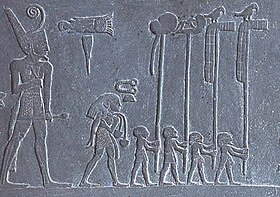Tjet
| Tjet in hieroglyphics | |||
|---|---|---|---|
| Thinite time |
Tjet Ṯt offspring / descendant |
||
| The panther skin carrier Tjet (in front of Narmer) | |||
Tjet is an ancient Egyptian title that is first documented in the Thinite period under King Narmer and was most likely reserved for the king's son as the bearer of the panther skin . The related religious exercise of the ritual of renewal was the responsibility of the designated heir to the throne in the early dynastic period .
background
In Egyptology , various translation proposals were discussed and associated with later dynastic titles such as Tjati (vizier) or Atjet (educator), which may have been derived from the function of the tjet.
On the Narmer palette, the wearer of the panther skin is inscribed with the title Tjet. Kurt Sethe suggested for the panther skin carrier Generated and heir apparent before as a translation of Tjet because he used the term of wetjet ( produce derived).
Bruce Williams rejects the equation with heir to the throne , since an early dynastic successor title is not proven and sees the activities of the Tjet in a ceremonial activity. Wolfgang Helck suspects that the Tjet is close to the king and sees the cult of Sem as a direct successor function, which later led to the Sem priesthood under Sahure and Niuserre .
Ute Rummler follows the approach of Kurt Sethe and Wolfgang Helck and translates the title Tjet with offspring or descendant . With regard to his family and political position, the eldest prince held central offices and can often be seen in pictures as wearing the panther skin.
On an early dynastic relief made of gels , a person can be seen with panther skin and youth locks , who supports the king in a ritual that was mostly performed by the prince's son. Another panther skin bearer can be seen on an early dynastic diorite bowl and can probably be identified as a king's son.
See also
literature
- Wolfgang Helck : Investigations into the official titles of the Egyptian Old Kingdom (= Ägyptologische Forschungen (AegFo). Vol. 18, ISSN 0933-338X ). Augustin, Glückstadt et al. 1954, pp. 16-17.
- Ute Rummel: The panther fur as a garment in cult. Meaning, symbolic content and theological location of a magical insignia. In: Imago Aegypti. Vol. 2, 2007 (2008), ISSN 1862-104X , pp. 109-152.
- Bruce Williams: The wearer of the leopard skin in the Naqada Period. In: Jacket Phillips (ed.): Ancient Egypt, the Aegean, and the Near East. Studies in honor of Martha Rhoads Bell. Volume 2. Van Siclen, San Antonio TX 1997, ISBN 0-933175-44-2 , pp. 483-496.
Web links
Individual evidence
- ↑ Elisabeth Staehlin: Investigations into the Egyptian costume in the Old Kingdom (= Münchner Ägyptologische Studien. Vol. 8). Hessling, Berlin 1966, pp. 65-66.
- ↑ Kurt Sethe : The ancient Egyptian pyramid texts. Based on the paper prints and photographs of the Berlin Museum. Volume 1: Text, first half: Spruch 1–468 (Pyr. 1–905). Hinrichs, Leipzig 1908, p. 11.
